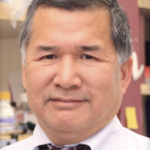IIDR Executive Committee
Matthew Miller
Scientific Director, IIDR
Associate Professor
Biochemistry & Biomedical Sciences
Research in the Miller Laboratory is divided into three main areas of focus: Innate & Adaptive Immunity Upon infection, both the innate and adaptive immune system is mobilized to protect the host from virus-mediated pathologies. The Miller Lab focuses on understanding both the protective and harmful qualities of immune responses – essential information for developing novel vaccines and therapeutics. Influenza Virus Influenza A virus (IAV) presents a particularly formidable challenge to the adaptive immune system. The virus has specific properties that allow it to cause seasonal epidemics and periodic pandemics, which leads to current- generation IAV vaccines having to be administered seasonally, while providing optimal protection against only a very limited number of IAV strains. However, a new class of antibodies has recently been discovered which is capable of providing much more broad protection across multiple IAV subtypes. The Miller group is focused on understanding the immunobiology of these antibodies, how they are elicited, and how they may be useful for the generation of “universal” influenza virus vaccines and therapeutics. ALS Abnormal inflammation is a signature of many neurodegenerative diseases, yet the way in which inflammation contributes to the pathology of these diseases is poorly defined. The Miller Lab is working to understand the role of inflammation in the etiology of neurodegenerative diseases, with a specific focus on its role in amyotrophic lateral sclerosis (ALS).

Matthew Miller
Scientific Director, IIDR
Associate Professor
Biochemistry & Biomedical Sciences
Lori Burrows
Associate Director, IIDR
Professor
Biochemistry & Biomedical Sciences
Type IV Pili
Many species of bacteria produce long, thin, flexible appendages called type IV pili (T4P). T4P can be rapidly and repeatedly extended and retracted, allowing bacteria to capture DNA and stick to different surfaces. T4P allows bacteria to ‘feel’ surface contact, which then turns on the expression of surface-associated genes, such as those involved in biofilm formation. Further, T4P are receptors for bacteriophages, and can even act as wires to conduct electricity in some species. The Burrows Lab investigates multiple aspects of T4P and has many ongoing projects ranging from studying the machine that makes T4P, the motor that extends and retracts them, the diversity of the subunits that make up T4P and its relationship to phage escape, and the regulatory pathways involved in surface sensing, among other projects.
Biofilms
Biofilms are communities of bacteria that grow on surfaces. They make cells more tolerant of disinfectants and antibiotics, making biofilm infections difficult to treat. The Burrows Lab studies how biofilms develop in response to chemical cues, particularly antibiotics. Sub-lethal concentrations of antibiotics stimulate biofilm formation – they study how this phenotype is induced, and exploit it to identify new antimicrobials in complex mixtures or compound libraries.

Lori Burrows
Associate Director, IIDR
Professor
Biochemistry & Biomedical Sciences
Dawn Bowdish
Professor
Medicine
Research interests in the Bowdish Lab include:
1) Understanding how macrophage phagocytosis changes with age and during acute and chronic inflammation, particularly in response to the pulmonary pathogen Streptococcus pneumoniae;
2) Determining how age-associated inflammation changes monocyte and macrophage development and function and increases susceptibility to infection;
3) Elucidating how age-associated inflammation changes immune function and alters the aging trajectory; and
4) Understanding how the microbiota contributes to healthy or unhealthy aging and how microbiome-host interactions can be harnessed to prevent infections.
Eric Brown
Professor
Biochemistry & Biomedical Sciences
Antibiotic resistance has reached crisis proportions, principally because modern industrial drug discovery efforts have failed to provide new antibiotics. The reasons for failure are manifold; however, a lack of understanding of the basic biology has played a large part. Where modern drug discovery emphasizes reductionist approaches, there is a profound risk of failure if the complexity of the target, indeed the system, is underestimated. Brown Lab researchers are investigating enigmatic processes that are essential for the survival of bacterial pathogens and are working to understand these processes in the context of complex cell systems. Dr. Eric Brown’s research group is also developing creative chemical-biology platforms to enable the discovery and characterization of new chemical probes with utility as tool compounds in exploring complex biology. Efforts to date have resulted in exciting new knowledge, platforms, chemical probes and lead compounds for antibacterial research.
Tracey Campbell
Research Manager
Tracey Campbell became the CMCB Research Manager in 2013 and is responsible for overseeing all facility activities. Tracey’s research career has been dedicated to infectious diseases and strategies to combat the ongoing problem of antimicrobial resistance. Tracey obtained her PhD in Biochemistry and Biomedical Sciences from McMaster University, where she worked in the laboratory of Dr. Eric Brown. From there, Tracey completed her postdoctoral studies at Princeton University, where she worked on novel strategies to combat malaria.
Brian Coombes
Professor & Chair
Biochemistry & Biomedical Sciences
Host-Pathogen Interactions
Bacteria secrete virulence factors in order to commandeer host cells and evade our immune system. Coombes Lab researchers use cutting-edge technologies in quantitative proteomics, functional genomics, and structural biology to understand the molecular mechanisms of bacterial pathogenesis and the actions of virulence factors. This knowledgebase creates opportunities for innovative drug target discovery with tangible impacts on public health.
Harnessing Immunity to Combat Superbugs
Pathogens use sophisticated strategies to overcome the innate immune system in order to colonize, establish a host niche, and transmit to new hosts. The Coombes Lab has embarked on a line of research to understand the components of the innate immune system involved in protection against enteric pathogens such as Salmonella, pathogenic E. coli, and bacteria associated with Crohn’s disease.
Crohn’s Disease
It is now accepted that Crohn’s disease is an inflammatory disease driven by microbes in our gut. However, mechanisms by which pathogenic or commensal microbes work in concert with each other and with host factors to drive this inflammation are not well known. Coombes Lab scientists are conducting basic research and working with the private sector to understand the microbes that drive chronic inflammation during Crohn’s disease, with a particular focus on adherent- invasive E. coli that are linked to Crohn’s disease in humans.

Brian Coombes
Professor & Chair
Biochemistry & Biomedical Sciences
David Earn
Professor
Mathematics & Statistics
Dr. David Earn develops and analyzes mathematical models of biological systems, primarily for applications in epidemiology, ecology and animal behaviour.
One of the main themes of his research is understanding and controlling extinctions. In the ecological context, he investigates strategies for the conservation of endangered species. In the epidemiological context, he studies strategies for the eradication of parasites that cause infectious diseases. From a mathematical point of view, these are very similar problems.
Another area of Dr. Earn’s research concerns the application of game theory to the evolutionary dynamics of behavioural traits. This work clarifies the adaptive significance of animal behaviour, ranging from cooperation and parental care to foraging and cannibalism.
Marie Elliot
Professor & Chair
Biology
The streptomycetes are Gram-positive, soil-dwelling bacteria renowned for their metabolic diversity and morphological complexity. They produce a vast array of compounds (known collectively as ‘secondary metabolites’) having profound medical benefits, including anti-cancer agents, immuno-suppressants, and more than 80% of commercially important antibiotics. In addition, Streptomyces have a multicellular life-cycle, differentiating into distinct tissue types in response to environmental stimuli, and provide a unique opportunity to explore cell differentiation in a simple, bacterial system. Intriguingly, differentiation and antibiotic production are intricately connected and share many regulatory links. Using genetic, biochemical, cell-biological and post-genomic technologies, the ultimate goals of Dr. Marie Elliot’s research program are:
1. To understand how cellular differentiation is achieved in a multi-Cellular bacterium;
2. To understand how newly discovered RNA regulators act to control differentiation, metabolism, and environmental adaptation; and
3. To develop ways of stimulating new antibiotic production, helping to overcome resistance to existing antibiotics and treat infectious disease.
Mark Loeb
Professor
Medicine
Pathology & Molecular Medicine
Dr. Mark Loeb’s research interests largely focus on epidemiologic and genomic population-based studies on viral infections such as influenza, West Nile, and dengue. His current projects include an NIH population genetics research program, a CIHR-funded cluster randomized controlled trial to reduce the spread of influenza by immunizing children in Hutterite colonies, and a CIHR-funded influenza pandemic team grant to establish the natural history, as well as immunologic and genetic determinants, of influenza infection. Dr. Loeb’s clinical focus encompasses general infectious diseases.

Mark Loeb
Professor
Medicine
Pathology & Molecular Medicine
John Whitney
Associate Professor
Biochemistry & Biomedical Sciences
Research in the Whitney Lab seeks to understand the molecular mechanisms that underlie microbe-microbe interactions.
Interbacterial Killing – By The Type VI Secretion System The bacterial type VI secretion system is a recently identified protein translocation pathway used by Gram-negative bacteria to deliver toxins to neighbouring bacteria in a cell contact-dependent manner. The Whitney Lab is interested in understanding how these antibacterial proteins are transported from one cell to another and how they exert toxicity once delivered to a target cell.
Type VII Secretion-dependent Interbacterial Antagonism – In contrast to their Gram-negative counterparts, the pathways involved in interbacterial antagonism between Gram-positive bacteria has long remained elusive. In recent work, the Whitney Lab and others have found that the type VII secretion system exports antibacterial toxins that mediate interbacterial competition. Elucidating the mode of action of these toxins will allow for the identification of new vulnerabilities in Gram-positive cells that can be exploited for the development of new antibiotics.
Exopolysaccharide Secretion and Interbacterial Adhesion – Many species of bacteria exist in dense cellular aggregates held together by bacterially produced exopolysaccharides. In this form, bacteria are difficult to eradicate due in part to decreased efficacy of antibiotics. The Whitney Lab is interested in determining how bacterial exopolysaccharides are synthesized and exported from the cell.

John Whitney
Associate Professor
Biochemistry & Biomedical Sciences
Gerry Wright
Lead, Global Nexus
Professor
Biochemistry & Biomedical Sciences
Antibiotics are vital components of modern medicine. However, their use is jeopardized by the spread of bacteria that have acquired resistance to their activity. This resistance can take many forms including enzymatic destruction of drugs, efflux, and target modification. To address the problem of antibiotic resistance, Dr. Gerry Wright’s lab is using complementary research strategies:
1 – The direct study of the molecular mechanisms of bacterial antibiotic resistance using chemical biology and chemical genetics;
2 – The identification of new antibiotics and new antimicrobial strategies.
These complementary approaches of fundamental and applied research are being pursued using a multidisciplinary approach, supported by state-of-the-art infrastructure within the Centre for Microbial Chemical Biology.

Gerry Wright
Lead, Global Nexus
Professor
Biochemistry & Biomedical Sciences
Matthew Miller
Scientific Director, IIDR
Associate Professor
Biochemistry & Biomedical Sciences
Research in the Miller Laboratory is divided into three main areas of focus: Innate & Adaptive Immunity Upon infection, both the innate and adaptive immune system is mobilized to protect the host from virus-mediated pathologies. The Miller Lab focuses on understanding both the protective and harmful qualities of immune responses – essential information for developing novel vaccines and therapeutics. Influenza Virus Influenza A virus (IAV) presents a particularly formidable challenge to the adaptive immune system. The virus has specific properties that allow it to cause seasonal epidemics and periodic pandemics, which leads to current- generation IAV vaccines having to be administered seasonally, while providing optimal protection against only a very limited number of IAV strains. However, a new class of antibodies has recently been discovered which is capable of providing much more broad protection across multiple IAV subtypes. The Miller group is focused on understanding the immunobiology of these antibodies, how they are elicited, and how they may be useful for the generation of “universal” influenza virus vaccines and therapeutics. ALS Abnormal inflammation is a signature of many neurodegenerative diseases, yet the way in which inflammation contributes to the pathology of these diseases is poorly defined. The Miller Lab is working to understand the role of inflammation in the etiology of neurodegenerative diseases, with a specific focus on its role in amyotrophic lateral sclerosis (ALS).
Matthew Miller
Scientific Director, IIDR
Associate Professor
Biochemistry & Biomedical Sciences
Research in the Miller Laboratory is divided into three main areas of focus: Innate & Adaptive Immunity Upon infection, both the innate and adaptive immune system is mobilized to protect the host from virus-mediated pathologies. The Miller Lab focuses on understanding both the protective and harmful qualities of immune responses – essential information for developing novel vaccines and therapeutics. Influenza Virus Influenza A virus (IAV) presents a particularly formidable challenge to the adaptive immune system. The virus has specific properties that allow it to cause seasonal epidemics and periodic pandemics, which leads to current- generation IAV vaccines having to be administered seasonally, while providing optimal protection against only a very limited number of IAV strains. However, a new class of antibodies has recently been discovered which is capable of providing much more broad protection across multiple IAV subtypes. The Miller group is focused on understanding the immunobiology of these antibodies, how they are elicited, and how they may be useful for the generation of “universal” influenza virus vaccines and therapeutics. ALS Abnormal inflammation is a signature of many neurodegenerative diseases, yet the way in which inflammation contributes to the pathology of these diseases is poorly defined. The Miller Lab is working to understand the role of inflammation in the etiology of neurodegenerative diseases, with a specific focus on its role in amyotrophic lateral sclerosis (ALS).
Lori Burrows
Associate Director, IIDR
Professor
Biochemistry & Biomedical Sciences
Type IV Pili
Many species of bacteria produce long, thin, flexible appendages called type IV pili (T4P). T4P can be rapidly and repeatedly extended and retracted, allowing bacteria to capture DNA and stick to different surfaces. T4P allows bacteria to ‘feel’ surface contact, which then turns on the expression of surface-associated genes, such as those involved in biofilm formation. Further, T4P are receptors for bacteriophages, and can even act as wires to conduct electricity in some species. The Burrows Lab investigates multiple aspects of T4P and has many ongoing projects ranging from studying the machine that makes T4P, the motor that extends and retracts them, the diversity of the subunits that make up T4P and its relationship to phage escape, and the regulatory pathways involved in surface sensing, among other projects.
Biofilms
Biofilms are communities of bacteria that grow on surfaces. They make cells more tolerant of disinfectants and antibiotics, making biofilm infections difficult to treat. The Burrows Lab studies how biofilms develop in response to chemical cues, particularly antibiotics. Sub-lethal concentrations of antibiotics stimulate biofilm formation – they study how this phenotype is induced, and exploit it to identify new antimicrobials in complex mixtures or compound libraries.
Lori Burrows
Associate Director, IIDR
Professor
Biochemistry & Biomedical Sciences
Type IV Pili
Many species of bacteria produce long, thin, flexible appendages called type IV pili (T4P). T4P can be rapidly and repeatedly extended and retracted, allowing bacteria to capture DNA and stick to different surfaces. T4P allows bacteria to ‘feel’ surface contact, which then turns on the expression of surface-associated genes, such as those involved in biofilm formation. Further, T4P are receptors for bacteriophages, and can even act as wires to conduct electricity in some species. The Burrows Lab investigates multiple aspects of T4P and has many ongoing projects ranging from studying the machine that makes T4P, the motor that extends and retracts them, the diversity of the subunits that make up T4P and its relationship to phage escape, and the regulatory pathways involved in surface sensing, among other projects.
Biofilms
Biofilms are communities of bacteria that grow on surfaces. They make cells more tolerant of disinfectants and antibiotics, making biofilm infections difficult to treat. The Burrows Lab studies how biofilms develop in response to chemical cues, particularly antibiotics. Sub-lethal concentrations of antibiotics stimulate biofilm formation – they study how this phenotype is induced, and exploit it to identify new antimicrobials in complex mixtures or compound libraries.
Dawn Bowdish
Professor
Medicine
Research interests in the Bowdish Lab include:
1) Understanding how macrophage phagocytosis changes with age and during acute and chronic inflammation, particularly in response to the pulmonary pathogen Streptococcus pneumoniae;
2) Determining how age-associated inflammation changes monocyte and macrophage development and function and increases susceptibility to infection;
3) Elucidating how age-associated inflammation changes immune function and alters the aging trajectory; and
4) Understanding how the microbiota contributes to healthy or unhealthy aging and how microbiome-host interactions can be harnessed to prevent infections.
Dawn Bowdish
Professor
Medicine
Research interests in the Bowdish Lab include:
1) Understanding how macrophage phagocytosis changes with age and during acute and chronic inflammation, particularly in response to the pulmonary pathogen Streptococcus pneumoniae;
2) Determining how age-associated inflammation changes monocyte and macrophage development and function and increases susceptibility to infection;
3) Elucidating how age-associated inflammation changes immune function and alters the aging trajectory; and
4) Understanding how the microbiota contributes to healthy or unhealthy aging and how microbiome-host interactions can be harnessed to prevent infections.
Eric Brown
Professor
Biochemistry & Biomedical Sciences
Antibiotic resistance has reached crisis proportions, principally because modern industrial drug discovery efforts have failed to provide new antibiotics. The reasons for failure are manifold; however, a lack of understanding of the basic biology has played a large part. Where modern drug discovery emphasizes reductionist approaches, there is a profound risk of failure if the complexity of the target, indeed the system, is underestimated. Brown Lab researchers are investigating enigmatic processes that are essential for the survival of bacterial pathogens and are working to understand these processes in the context of complex cell systems. Dr. Eric Brown’s research group is also developing creative chemical-biology platforms to enable the discovery and characterization of new chemical probes with utility as tool compounds in exploring complex biology. Efforts to date have resulted in exciting new knowledge, platforms, chemical probes and lead compounds for antibacterial research.
Eric Brown
Professor
Biochemistry & Biomedical Sciences
Antibiotic resistance has reached crisis proportions, principally because modern industrial drug discovery efforts have failed to provide new antibiotics. The reasons for failure are manifold; however, a lack of understanding of the basic biology has played a large part. Where modern drug discovery emphasizes reductionist approaches, there is a profound risk of failure if the complexity of the target, indeed the system, is underestimated. Brown Lab researchers are investigating enigmatic processes that are essential for the survival of bacterial pathogens and are working to understand these processes in the context of complex cell systems. Dr. Eric Brown’s research group is also developing creative chemical-biology platforms to enable the discovery and characterization of new chemical probes with utility as tool compounds in exploring complex biology. Efforts to date have resulted in exciting new knowledge, platforms, chemical probes and lead compounds for antibacterial research.
Tracey Campbell
Research Manager
Tracey Campbell became the CMCB Research Manager in 2013 and is responsible for overseeing all facility activities. Tracey’s research career has been dedicated to infectious diseases and strategies to combat the ongoing problem of antimicrobial resistance. Tracey obtained her PhD in Biochemistry and Biomedical Sciences from McMaster University, where she worked in the laboratory of Dr. Eric Brown. From there, Tracey completed her postdoctoral studies at Princeton University, where she worked on novel strategies to combat malaria.
Tracey Campbell
Research Manager
Tracey Campbell became the CMCB Research Manager in 2013 and is responsible for overseeing all facility activities. Tracey’s research career has been dedicated to infectious diseases and strategies to combat the ongoing problem of antimicrobial resistance. Tracey obtained her PhD in Biochemistry and Biomedical Sciences from McMaster University, where she worked in the laboratory of Dr. Eric Brown. From there, Tracey completed her postdoctoral studies at Princeton University, where she worked on novel strategies to combat malaria.
Brian Coombes
Professor & Chair
Biochemistry & Biomedical Sciences
Host-Pathogen Interactions
Bacteria secrete virulence factors in order to commandeer host cells and evade our immune system. Coombes Lab researchers use cutting-edge technologies in quantitative proteomics, functional genomics, and structural biology to understand the molecular mechanisms of bacterial pathogenesis and the actions of virulence factors. This knowledgebase creates opportunities for innovative drug target discovery with tangible impacts on public health.
Harnessing Immunity to Combat Superbugs
Pathogens use sophisticated strategies to overcome the innate immune system in order to colonize, establish a host niche, and transmit to new hosts. The Coombes Lab has embarked on a line of research to understand the components of the innate immune system involved in protection against enteric pathogens such as Salmonella, pathogenic E. coli, and bacteria associated with Crohn’s disease.
Crohn’s Disease
It is now accepted that Crohn’s disease is an inflammatory disease driven by microbes in our gut. However, mechanisms by which pathogenic or commensal microbes work in concert with each other and with host factors to drive this inflammation are not well known. Coombes Lab scientists are conducting basic research and working with the private sector to understand the microbes that drive chronic inflammation during Crohn’s disease, with a particular focus on adherent- invasive E. coli that are linked to Crohn’s disease in humans.
Brian Coombes
Professor & Chair
Biochemistry & Biomedical Sciences
Host-Pathogen Interactions
Bacteria secrete virulence factors in order to commandeer host cells and evade our immune system. Coombes Lab researchers use cutting-edge technologies in quantitative proteomics, functional genomics, and structural biology to understand the molecular mechanisms of bacterial pathogenesis and the actions of virulence factors. This knowledgebase creates opportunities for innovative drug target discovery with tangible impacts on public health.
Harnessing Immunity to Combat Superbugs
Pathogens use sophisticated strategies to overcome the innate immune system in order to colonize, establish a host niche, and transmit to new hosts. The Coombes Lab has embarked on a line of research to understand the components of the innate immune system involved in protection against enteric pathogens such as Salmonella, pathogenic E. coli, and bacteria associated with Crohn’s disease.
Crohn’s Disease
It is now accepted that Crohn’s disease is an inflammatory disease driven by microbes in our gut. However, mechanisms by which pathogenic or commensal microbes work in concert with each other and with host factors to drive this inflammation are not well known. Coombes Lab scientists are conducting basic research and working with the private sector to understand the microbes that drive chronic inflammation during Crohn’s disease, with a particular focus on adherent- invasive E. coli that are linked to Crohn’s disease in humans.
David Earn
Professor
Mathematics & Statistics
Dr. David Earn develops and analyzes mathematical models of biological systems, primarily for applications in epidemiology, ecology and animal behaviour.
One of the main themes of his research is understanding and controlling extinctions. In the ecological context, he investigates strategies for the conservation of endangered species. In the epidemiological context, he studies strategies for the eradication of parasites that cause infectious diseases. From a mathematical point of view, these are very similar problems.
Another area of Dr. Earn’s research concerns the application of game theory to the evolutionary dynamics of behavioural traits. This work clarifies the adaptive significance of animal behaviour, ranging from cooperation and parental care to foraging and cannibalism.
David Earn
Professor
Mathematics & Statistics
Dr. David Earn develops and analyzes mathematical models of biological systems, primarily for applications in epidemiology, ecology and animal behaviour.
One of the main themes of his research is understanding and controlling extinctions. In the ecological context, he investigates strategies for the conservation of endangered species. In the epidemiological context, he studies strategies for the eradication of parasites that cause infectious diseases. From a mathematical point of view, these are very similar problems.
Another area of Dr. Earn’s research concerns the application of game theory to the evolutionary dynamics of behavioural traits. This work clarifies the adaptive significance of animal behaviour, ranging from cooperation and parental care to foraging and cannibalism.
Marie Elliot
Professor & Chair
Biology
The streptomycetes are Gram-positive, soil-dwelling bacteria renowned for their metabolic diversity and morphological complexity. They produce a vast array of compounds (known collectively as ‘secondary metabolites’) having profound medical benefits, including anti-cancer agents, immuno-suppressants, and more than 80% of commercially important antibiotics. In addition, Streptomyces have a multicellular life-cycle, differentiating into distinct tissue types in response to environmental stimuli, and provide a unique opportunity to explore cell differentiation in a simple, bacterial system. Intriguingly, differentiation and antibiotic production are intricately connected and share many regulatory links. Using genetic, biochemical, cell-biological and post-genomic technologies, the ultimate goals of Dr. Marie Elliot’s research program are:
1. To understand how cellular differentiation is achieved in a multi-Cellular bacterium;
2. To understand how newly discovered RNA regulators act to control differentiation, metabolism, and environmental adaptation; and
3. To develop ways of stimulating new antibiotic production, helping to overcome resistance to existing antibiotics and treat infectious disease.
Marie Elliot
Professor & Chair
Biology
The streptomycetes are Gram-positive, soil-dwelling bacteria renowned for their metabolic diversity and morphological complexity. They produce a vast array of compounds (known collectively as ‘secondary metabolites’) having profound medical benefits, including anti-cancer agents, immuno-suppressants, and more than 80% of commercially important antibiotics. In addition, Streptomyces have a multicellular life-cycle, differentiating into distinct tissue types in response to environmental stimuli, and provide a unique opportunity to explore cell differentiation in a simple, bacterial system. Intriguingly, differentiation and antibiotic production are intricately connected and share many regulatory links. Using genetic, biochemical, cell-biological and post-genomic technologies, the ultimate goals of Dr. Marie Elliot’s research program are:
1. To understand how cellular differentiation is achieved in a multi-Cellular bacterium;
2. To understand how newly discovered RNA regulators act to control differentiation, metabolism, and environmental adaptation; and
3. To develop ways of stimulating new antibiotic production, helping to overcome resistance to existing antibiotics and treat infectious disease.
Mark Loeb
Professor
Medicine
Pathology & Molecular Medicine
Dr. Mark Loeb’s research interests largely focus on epidemiologic and genomic population-based studies on viral infections such as influenza, West Nile, and dengue. His current projects include an NIH population genetics research program, a CIHR-funded cluster randomized controlled trial to reduce the spread of influenza by immunizing children in Hutterite colonies, and a CIHR-funded influenza pandemic team grant to establish the natural history, as well as immunologic and genetic determinants, of influenza infection. Dr. Loeb’s clinical focus encompasses general infectious diseases.
Mark Loeb
Professor
Medicine
Pathology & Molecular Medicine
Dr. Mark Loeb’s research interests largely focus on epidemiologic and genomic population-based studies on viral infections such as influenza, West Nile, and dengue. His current projects include an NIH population genetics research program, a CIHR-funded cluster randomized controlled trial to reduce the spread of influenza by immunizing children in Hutterite colonies, and a CIHR-funded influenza pandemic team grant to establish the natural history, as well as immunologic and genetic determinants, of influenza infection. Dr. Loeb’s clinical focus encompasses general infectious diseases.
John Whitney
Associate Professor
Biochemistry & Biomedical Sciences
Research in the Whitney Lab seeks to understand the molecular mechanisms that underlie microbe-microbe interactions.
Interbacterial Killing – By The Type VI Secretion System The bacterial type VI secretion system is a recently identified protein translocation pathway used by Gram-negative bacteria to deliver toxins to neighbouring bacteria in a cell contact-dependent manner. The Whitney Lab is interested in understanding how these antibacterial proteins are transported from one cell to another and how they exert toxicity once delivered to a target cell.
Type VII Secretion-dependent Interbacterial Antagonism – In contrast to their Gram-negative counterparts, the pathways involved in interbacterial antagonism between Gram-positive bacteria has long remained elusive. In recent work, the Whitney Lab and others have found that the type VII secretion system exports antibacterial toxins that mediate interbacterial competition. Elucidating the mode of action of these toxins will allow for the identification of new vulnerabilities in Gram-positive cells that can be exploited for the development of new antibiotics.
Exopolysaccharide Secretion and Interbacterial Adhesion – Many species of bacteria exist in dense cellular aggregates held together by bacterially produced exopolysaccharides. In this form, bacteria are difficult to eradicate due in part to decreased efficacy of antibiotics. The Whitney Lab is interested in determining how bacterial exopolysaccharides are synthesized and exported from the cell.
John Whitney
Associate Professor
Biochemistry & Biomedical Sciences
Research in the Whitney Lab seeks to understand the molecular mechanisms that underlie microbe-microbe interactions.
Interbacterial Killing – By The Type VI Secretion System The bacterial type VI secretion system is a recently identified protein translocation pathway used by Gram-negative bacteria to deliver toxins to neighbouring bacteria in a cell contact-dependent manner. The Whitney Lab is interested in understanding how these antibacterial proteins are transported from one cell to another and how they exert toxicity once delivered to a target cell.
Type VII Secretion-dependent Interbacterial Antagonism – In contrast to their Gram-negative counterparts, the pathways involved in interbacterial antagonism between Gram-positive bacteria has long remained elusive. In recent work, the Whitney Lab and others have found that the type VII secretion system exports antibacterial toxins that mediate interbacterial competition. Elucidating the mode of action of these toxins will allow for the identification of new vulnerabilities in Gram-positive cells that can be exploited for the development of new antibiotics.
Exopolysaccharide Secretion and Interbacterial Adhesion – Many species of bacteria exist in dense cellular aggregates held together by bacterially produced exopolysaccharides. In this form, bacteria are difficult to eradicate due in part to decreased efficacy of antibiotics. The Whitney Lab is interested in determining how bacterial exopolysaccharides are synthesized and exported from the cell.
Gerry Wright
Lead, Global Nexus
Professor
Biochemistry & Biomedical Sciences
Antibiotics are vital components of modern medicine. However, their use is jeopardized by the spread of bacteria that have acquired resistance to their activity. This resistance can take many forms including enzymatic destruction of drugs, efflux, and target modification. To address the problem of antibiotic resistance, Dr. Gerry Wright’s lab is using complementary research strategies:
1 – The direct study of the molecular mechanisms of bacterial antibiotic resistance using chemical biology and chemical genetics;
2 – The identification of new antibiotics and new antimicrobial strategies.
These complementary approaches of fundamental and applied research are being pursued using a multidisciplinary approach, supported by state-of-the-art infrastructure within the Centre for Microbial Chemical Biology.
Gerry Wright
Lead, Global Nexus
Professor
Biochemistry & Biomedical Sciences
Antibiotics are vital components of modern medicine. However, their use is jeopardized by the spread of bacteria that have acquired resistance to their activity. This resistance can take many forms including enzymatic destruction of drugs, efflux, and target modification. To address the problem of antibiotic resistance, Dr. Gerry Wright’s lab is using complementary research strategies:
1 – The direct study of the molecular mechanisms of bacterial antibiotic resistance using chemical biology and chemical genetics;
2 – The identification of new antibiotics and new antimicrobial strategies.
These complementary approaches of fundamental and applied research are being pursued using a multidisciplinary approach, supported by state-of-the-art infrastructure within the Centre for Microbial Chemical Biology.
Scientific Advisory Board
Patricia Bradford
Patricia Bradford is the founder of Antimicrobial Development Specialists, LLC. Previously, she has worked for industry leaders including AstraZeneca Pharmaceuticals, Novartis, Wyeth, and Lederle Pharmaceuticals, where she contributed to several development programs for antibiotics including piperacillin-tazobactam, tigecycline, and ceftazidime-avibactam. She has also led significant biology efforts on discovery platforms for antibiotics and antivirals and has managed a diverse group of scientists working in microbiology, pharmacology, biochemistry, and bioinformatics.

Patricia Bradford
Patricia Bradford is the founder of Antimicrobial Development Specialists, LLC. Previously, she has worked for industry leaders including AstraZeneca Pharmaceuticals, Novartis, Wyeth, and Lederle Pharmaceuticals, where she contributed to several development programs for antibiotics including piperacillin-tazobactam, tigecycline, and ceftazidime-avibactam. She has also led significant biology efforts on discovery platforms for antibiotics and antivirals and has managed a diverse group of scientists working in microbiology, pharmacology, biochemistry, and bioinformatics.
Ferric Fang
Ferric Fang is a Professor of Laboratory Medicine and Microbiology and Adjunct Professor of Medicine and Pathobiology at the University of Washington, and Director of Clinical Microbiology at the Harborview Medical Center. Dr. Fang is presently Editor-in-Chief of the journal Infection and Immunity, Director of the UW Interdisciplinary Training Program in Bacterial Pathogenesis, past Chair of the American Society for Microbiology General Meeting, and an elected member of the American Society for Clinical Investigation and the American Academy of Microbiology.

Ferric Fang
Ferric Fang is a Professor of Laboratory Medicine and Microbiology and Adjunct Professor of Medicine and Pathobiology at the University of Washington, and Director of Clinical Microbiology at the Harborview Medical Center. Dr. Fang is presently Editor-in-Chief of the journal Infection and Immunity, Director of the UW Interdisciplinary Training Program in Bacterial Pathogenesis, past Chair of the American Society for Microbiology General Meeting, and an elected member of the American Society for Clinical Investigation and the American Academy of Microbiology.
Deborah Hung
Deborah Hung is a trained physician, chemist, and geneticist. She received her PhD in Chemistry at Harvard University, where she worked on characterizing the chemical and biological properties of a microtubule-stabilizing molecule called discodermolide. Dr. Hung completed a postdoctoral fellowship at Harvard, where she used high-throughput screening to identify small molecule inhibitors of Vibrio cholerae virulence factors. She further received her Doctor of Medicine from Harvard Medical School, completing a residency in internal medicine and fellowships in infectious disease and critical care medicine.

Deborah Hung
Deborah Hung is a trained physician, chemist, and geneticist. She received her PhD in Chemistry at Harvard University, where she worked on characterizing the chemical and biological properties of a microtubule-stabilizing molecule called discodermolide. Dr. Hung completed a postdoctoral fellowship at Harvard, where she used high-throughput screening to identify small molecule inhibitors of Vibrio cholerae virulence factors. She further received her Doctor of Medicine from Harvard Medical School, completing a residency in internal medicine and fellowships in infectious disease and critical care medicine.
Marc Lipsitch
Marc Lipsitch is a Professor of Epidemiology with a primary appointment in the Department of Epidemiology and a joint appointment in the Department of Immunology and Infectious Diseases at the Harvard T.H. Chan School of Public Health. He directs the Center for Communicable Disease Dynamics and is the Associate Director of the Interdisciplinary Concentration in Infectious Disease Epidemiology. His research concerns the effect of naturally acquired host immunity, vaccine-induced immunity, and other public health interventions on the population biology of pathogens and the consequences of changing pathogen populations for human health.

Marc Lipsitch
Marc Lipsitch is a Professor of Epidemiology with a primary appointment in the Department of Epidemiology and a joint appointment in the Department of Immunology and Infectious Diseases at the Harvard T.H. Chan School of Public Health. He directs the Center for Communicable Disease Dynamics and is the Associate Director of the Interdisciplinary Concentration in Infectious Disease Epidemiology. His research concerns the effect of naturally acquired host immunity, vaccine-induced immunity, and other public health interventions on the population biology of pathogens and the consequences of changing pathogen populations for human health.
Allison McGeer
Allison McGeer is Professor of Public Health Sciences and Laboratory Medicine & Pathobiology at the University of Toronto. She is also a microbiologist and Director of Infection Control at Toronto’s Mount Sinai Hospital, as well as an infection control consultant to several hospitals throughout Ontario. Her research interests include the prevention of healthcare-associated infections and the use of surveillance to advance the prevention, diagnosis, and treatment of infectious diseases.

Allison McGeer
Allison McGeer is Professor of Public Health Sciences and Laboratory Medicine & Pathobiology at the University of Toronto. She is also a microbiologist and Director of Infection Control at Toronto’s Mount Sinai Hospital, as well as an infection control consultant to several hospitals throughout Ontario. Her research interests include the prevention of healthcare-associated infections and the use of surveillance to advance the prevention, diagnosis, and treatment of infectious diseases.
Patricia Bradford
Patricia Bradford is the founder of Antimicrobial Development Specialists, LLC. Previously, she has worked for industry leaders including AstraZeneca Pharmaceuticals, Novartis, Wyeth, and Lederle Pharmaceuticals, where she contributed to several development programs for antibiotics including piperacillin-tazobactam, tigecycline, and ceftazidime-avibactam. She has also led significant biology efforts on discovery platforms for antibiotics and antivirals and has managed a diverse group of scientists working in microbiology, pharmacology, biochemistry, and bioinformatics.
Patricia Bradford
Patricia Bradford is the founder of Antimicrobial Development Specialists, LLC. Previously, she has worked for industry leaders including AstraZeneca Pharmaceuticals, Novartis, Wyeth, and Lederle Pharmaceuticals, where she contributed to several development programs for antibiotics including piperacillin-tazobactam, tigecycline, and ceftazidime-avibactam. She has also led significant biology efforts on discovery platforms for antibiotics and antivirals and has managed a diverse group of scientists working in microbiology, pharmacology, biochemistry, and bioinformatics.
Ferric Fang
Ferric Fang is a Professor of Laboratory Medicine and Microbiology and Adjunct Professor of Medicine and Pathobiology at the University of Washington, and Director of Clinical Microbiology at the Harborview Medical Center. Dr. Fang is presently Editor-in-Chief of the journal Infection and Immunity, Director of the UW Interdisciplinary Training Program in Bacterial Pathogenesis, past Chair of the American Society for Microbiology General Meeting, and an elected member of the American Society for Clinical Investigation and the American Academy of Microbiology.
Ferric Fang
Ferric Fang is a Professor of Laboratory Medicine and Microbiology and Adjunct Professor of Medicine and Pathobiology at the University of Washington, and Director of Clinical Microbiology at the Harborview Medical Center. Dr. Fang is presently Editor-in-Chief of the journal Infection and Immunity, Director of the UW Interdisciplinary Training Program in Bacterial Pathogenesis, past Chair of the American Society for Microbiology General Meeting, and an elected member of the American Society for Clinical Investigation and the American Academy of Microbiology.
Deborah Hung
Deborah Hung is a trained physician, chemist, and geneticist. She received her PhD in Chemistry at Harvard University, where she worked on characterizing the chemical and biological properties of a microtubule-stabilizing molecule called discodermolide. Dr. Hung completed a postdoctoral fellowship at Harvard, where she used high-throughput screening to identify small molecule inhibitors of Vibrio cholerae virulence factors. She further received her Doctor of Medicine from Harvard Medical School, completing a residency in internal medicine and fellowships in infectious disease and critical care medicine.
Deborah Hung
Deborah Hung is a trained physician, chemist, and geneticist. She received her PhD in Chemistry at Harvard University, where she worked on characterizing the chemical and biological properties of a microtubule-stabilizing molecule called discodermolide. Dr. Hung completed a postdoctoral fellowship at Harvard, where she used high-throughput screening to identify small molecule inhibitors of Vibrio cholerae virulence factors. She further received her Doctor of Medicine from Harvard Medical School, completing a residency in internal medicine and fellowships in infectious disease and critical care medicine.
Marc Lipsitch
Marc Lipsitch is a Professor of Epidemiology with a primary appointment in the Department of Epidemiology and a joint appointment in the Department of Immunology and Infectious Diseases at the Harvard T.H. Chan School of Public Health. He directs the Center for Communicable Disease Dynamics and is the Associate Director of the Interdisciplinary Concentration in Infectious Disease Epidemiology. His research concerns the effect of naturally acquired host immunity, vaccine-induced immunity, and other public health interventions on the population biology of pathogens and the consequences of changing pathogen populations for human health.
Marc Lipsitch
Marc Lipsitch is a Professor of Epidemiology with a primary appointment in the Department of Epidemiology and a joint appointment in the Department of Immunology and Infectious Diseases at the Harvard T.H. Chan School of Public Health. He directs the Center for Communicable Disease Dynamics and is the Associate Director of the Interdisciplinary Concentration in Infectious Disease Epidemiology. His research concerns the effect of naturally acquired host immunity, vaccine-induced immunity, and other public health interventions on the population biology of pathogens and the consequences of changing pathogen populations for human health.
Allison McGeer
Allison McGeer is Professor of Public Health Sciences and Laboratory Medicine & Pathobiology at the University of Toronto. She is also a microbiologist and Director of Infection Control at Toronto’s Mount Sinai Hospital, as well as an infection control consultant to several hospitals throughout Ontario. Her research interests include the prevention of healthcare-associated infections and the use of surveillance to advance the prevention, diagnosis, and treatment of infectious diseases.
Allison McGeer
Allison McGeer is Professor of Public Health Sciences and Laboratory Medicine & Pathobiology at the University of Toronto. She is also a microbiologist and Director of Infection Control at Toronto’s Mount Sinai Hospital, as well as an infection control consultant to several hospitals throughout Ontario. Her research interests include the prevention of healthcare-associated infections and the use of surveillance to advance the prevention, diagnosis, and treatment of infectious diseases.






